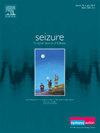癫痫--前额基底病变手术:管理、结果和文献综述。
IF 2.7
3区 医学
Q2 CLINICAL NEUROLOGY
引用次数: 0
摘要
研究背景在这项研究中,我们分离了一批接受前基底病灶手术的难治性癫痫患者。这项工作的目的是制定与更好的癫痫发作结果相关的预后因素,并确定决定术后发病率的风险因素:我们确定了 22 年来在波恩大学医院因难治性癫痫而接受手术治疗的所有前基底节癫痫患者。虽然这是一项回顾性研究,但所有数据都是前瞻性收集的。我们对手术和功能结果进行了评估:本研究共确定了 32 名患者。术后癫痫发作结果长期稳定,平均为109个月,我们能够证明前基底节癫痫患者比额叶癫痫患者能获得更好的疗效(53%无发作,ILAE1)。与其他脑区相比,切除范围(孤立或扩大)并不影响疗效。另一方面,低级别肿瘤与较好的癫痫发作预后有关,而神经胶质增生或非特异性组织学发现与较差的癫痫发作预后有关。与条状或网格状电极相比,使用深度电极的立体电子脑电图更适合额底的侵入性诊断。手术后未恢复癫痫发作并接受第二次手术的患者在癫痫发作预后方面没有明显获益:结论:在病程早期接受手术、核磁共振成像呈阳性且肿瘤为致痫病理的额叶癫痫患者最有可能摆脱癫痫发作。本文章由计算机程序翻译,如有差异,请以英文原文为准。
Epilepsy-surgery for fronto-basal lesions: Management, outcome, and review of literature
Background
In this study, we isolated a cohort of patients who have refractory epilepsy who underwent surgery with frontobasal focus. This work aimed to develop prognostic factors associated with a better seizure outcome and identify risk factors determining postoperative morbidity.
Methods
We identified all patients with frontobasal epilepsy who underwent surgery due to refractory epilepsy at the University Hospital Bonn over 22 years. Although this is a retrospective study, all data sets were collected prospectively. We evaluated both surgical and functional outcomes.
Results
In total, 32 patients were identified for inclusion in this study. With a long and stable postoperative seizure outcome averaging 109 months, we were able to show that patients with frontobasal epilepsy can achieve a better outcome (53 % seizure-free, ILAE1) than patients with frontal epilepsy. In contrast to other brain regions, the resection size (isolated or extended) did not influence the outcome. Low-grade tumors, on the other hand, were associated with a better seizure outcome, and gliosis or non-specific histological findings with a worse seizure outcome. Stereo-EEG with depth electrodes is more suitable for invasive diagnostics at the frontal base than strip or grid electrodes. Patients who did not become seizure-free after surgery and underwent a second surgery did not profit significantly concerning seizure outcome.
Conclusion
Patients with frontobasal epilepsy who are operated on early in the course of the disease, are MRI-positive, and have a tumor as an epileptogenic pathology have the best chance of seizure freedom.
求助全文
通过发布文献求助,成功后即可免费获取论文全文。
去求助
来源期刊

Seizure-European Journal of Epilepsy
医学-临床神经学
CiteScore
5.60
自引率
6.70%
发文量
231
审稿时长
34 days
期刊介绍:
Seizure - European Journal of Epilepsy is an international journal owned by Epilepsy Action (the largest member led epilepsy organisation in the UK). It provides a forum for papers on all topics related to epilepsy and seizure disorders.
 求助内容:
求助内容: 应助结果提醒方式:
应助结果提醒方式:


